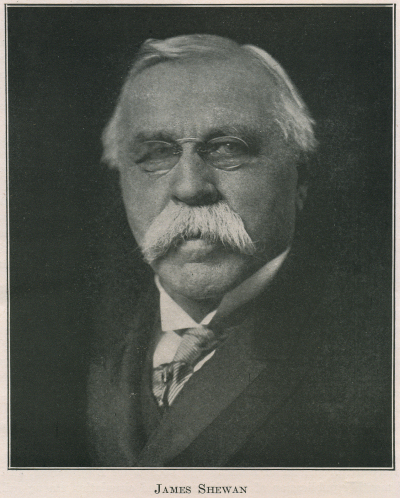|

JAMES SHEWAN, founder of the largest
dry dock and ship-repairing plant in the port of New York, was a native of
Aberdeenshire, born January 6, 1848, at Rora, near Peterhead, the son of
James and Agnes Robertson Shewan. His father died when he was four years
of age. James attended school for only a few years, and in his early teens
was apprenticed to a ship-carpenter; during this time he studied
diligently in night-school. His first voyage was to Greenland, where the
ship was held by the ice for three and a half months, and they almost gave
up hope of ever getting back to Scotland. Soon after his return he went to
London and went on a voyage with his uncle, a sea captain, to Singapore,
and for four years the ship traded in tea at various ports in China, Japan
and Australia. He came from Yokohama to New York in 1869, at the age of
twenty-one, and worked at his trade for four months; and then started a
dry-dock and ship-repairing business under the name of Shewan & Palmer,
which afterward became Shewan & Jenkins. In 1877 he bought out
Mr.
Jenkins, and for thirty-six years carried on the
business independently.
Mr. Shewan was most successful in
building up a large and prosperous business. The plant is ideally situated
at the foot of Twenty-fifth, Twenty-sixth and Twenty-seventh Streets,
Brooklyn, and has the most extensive tonnage of any yard in America; four
of the docks were moved from Manhattan in 1913. It is central to all of
the principal steamship piers in the entire port; also is directly on the
forty-foot Bay Ridge Channel connecting with the Ambrose Channel, thereby
enabling vessels of the deepest draught to be dry-docked or moored
alongside at any stage of the tide. The ship-building plant consists of
machine-shop, boiler-shop, joiner-shop, steam forge, cooper and blacksmith
shops, and has every appliance necessary for dry dock and for repairing
ocean steamships in all branches of workmanship. It employs regularly
about two thousand men, and the firm is one of the busiest in the port of
New York. The yard is equipped with a modern electric-lighting plant, thus
enabling the work to go on day and night. The largest dry dock can lift
out of the water a ship of 12,000 tons. It is constructed of steel, and is
of the type adopted by the British Admiralty for docking warships. Mr.
Shewan also invested largely in valuable real estate, and accummulated a
fortune that enabled him to finance his shipyard without accommodation
from banks or any other concern.
Since Mr. Shewan’s death, May 7,
1914, the business, previously incorporated as James Shewan & Sons, has
been continued under the able management of his sons, James Shewan,
President, and Edwin A. Shewan, Vice-President. The sons received their
training from an early age under their father, beginning at the bottom and
earning every promotion. There is not a detail of the business of which
they do not have a practical knowledge.
In 1870 Mr. Shewan married Miss
Ellen Curley, a native of Cardiff, South Wales, a most congenial and
inspiring companion. They had two
sons, James
and Edwin Arthur, and three daughters, Nellie, Agnes
and Ada.
Mrs. Shewan and her accomplished
daughters spend the summers on their estate, "Inverugie," on the banks of
the Hudson, opposite West Point, one of the most beautiful in the
Highlands; their winters, in New York and in travel. Mrs. Shewan is a
gracious and generous mother, and kindly and hospitable to the many
friends of the family.
Mr. Shewan was a genuine Scot,
broad-minded and warm-hearted, fond of golf and all out-door sports.
Notwithstanding his busy life, he improved his mind by reading and by
extensive travel, so that he was well-posted on all literary subjects,
especially history. He made many tours in Great Britain and on the
Continent, in his own car, always accompanied by his esteemed wife and
charming daughters, who were his constant companions. His home-life was
most refined and hospitable; and he delighted in entertaining his many
friends on his private golf links at "Inverugie." He was a member of St.
Andrew’s Society of the State of New York, and had all the qualities of
the Scottish race, which he exhibited in his daily life. He took a
friendly interest in and was greatly respected by the army of workmen whom
he employed and applied in his business the ethics of the Presbyterian
faith, in which he was brought up and lived. |

